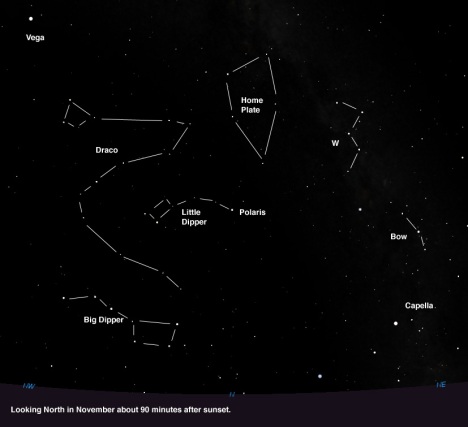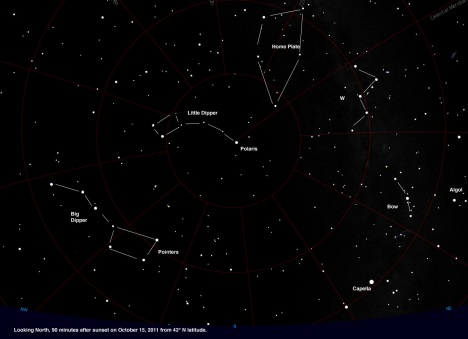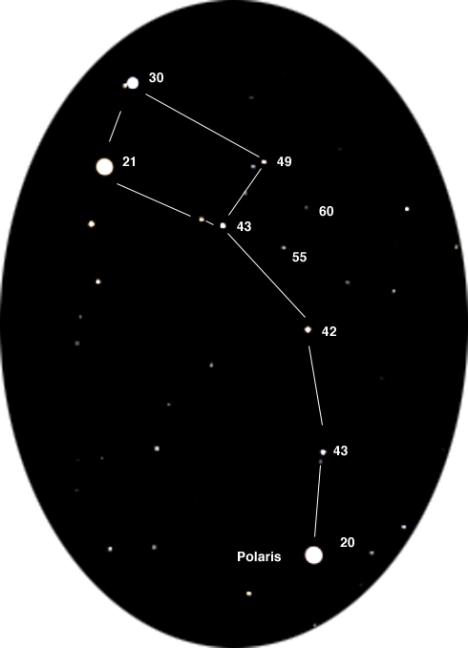
- Click for larger image. (Developed from Starry Nights Pro screen shot.)
Click here to download a printer-friendly version of this chart.
Is the North Star – Polaris – our brightest star? No! And it certainly won’t look that way this month as it shares the northern sky with two very bright stars. But, read on. Polaris is not nearly as dim as it looks!
If you have been learning your guidepost stars as they rise in the East, you won’t be surprised by the two bright stars which flank – and outshine – our pole star in May. To the northwest is Capella, a star we first met when it rose in the northeast in November. In May the northeast is dominated by a star that is almost Capella’s twin in brightness, Vega, a guidepost star we introduce in May. (See “Look East!” for more about Vega.) As a bonus we also have the twin guidepost stars, Castor and Pollux, making their way into the northern sky high above Capella. But let’s focus on Capella and Vega.
New star watchers frequently assume the North Star, Polaris, will be the brightest star in the sky. It isn’t even close! It is bright, but its fame comes because it’s very, very close to where the axis of the Earth points to the north celestial pole. So it serves anyone trying to find true north as a very good guide. But when it comes to brightness, it’s in the same league as the stars in the Big Dipper. Quite bright, but it can’t hold a candle to Capella and Vega. When you look at a list of the brightest stars, Vega is number 5 and Capella number 6. Polaris, our North Star, is number 48!
As simple as one, two, three!
That doesn’t mean Polaris is a slouch, though. First, in the eastern sky in May you meet Spica. (That’s on our chart for the east.) One distinction of Spica is that it’s as close to being magnitude 1 as any star gets. A distinction of Polaris is, as Spica defines magnitude 1, Polaris defines magnitude 2. (To be precise it’s magnitude 2.02.) Vega and Capella are extremely close to magnitude 0. Vega is 0.03 and Capella 0.08. Good luck on telling the difference! This month, if you look north 90 minutes after sunset, you may think Capella is a bit brighter actually – but if it appears that way it will be because it’s a bit higher in the sky and thus is not dimmed by having to fight its way through as much of our atmosphere as Vega is doing at the moment. So don’t try to split hairs. And yes, you’re right – they are NOT really as “simple as one, two, three” – on the magnitude scale they are as simple as zero, one, two – but that doesn’t sound as good! (Vega and Capella are zero; Spica is magnitude one, and Polaris, magnitude two.)
So which is really the brightest star of these four? Are you ready for this? Polaris! That’s right – if you put all four stars at the same distance, Polaris would appear to be the brightest. Remember, that the lower the magnitude number, the brighter the star. In absolute magnitude – the brightness we give to a star if they are all shining fromt he same distance -these four stars line up this way:
- Polaris -3.4
- Spica -3.2
- Capella 0.1
- Vega 0.3
And those absolute magnitudes also reflect their order in distance from us.
- Polaris 433 light years
- Spica 250 light years
- Capella 45 light years
- Vega 25 light years
So sometimes a star is very bright because it’s – well, very bright. But sometimes it only appears to be very bright because it is very close to us. If you put our closest star into this group, our Sun – remember, it is just 8 light minutes from us – in absolute magnitude it would be by far the dimmest of this group – absolute magnitude 4.9! So while Polaris doesn’t look all that bright, it really is a very bright star! Another way to think about this is if you move our Sun out to where Polaris is, it would be about magnitude 10! You would need binoculars or a telescope to see it!

- Click image for larger view of this chart. Yellow circle represents typical field of view for low power binoculars, such as 10X50.
To get an idea of the difference between Polaris and our Sun, point your binoculars towards Polaris. You should be able to make out the “Engagement Ring” asterism – granted, a crude ring with Polaris as the diamond. This asterism points you towards the true north celestial pole – just avery short distance to the other side of Polaris – and also gives you a good idea of about how far Polaris is from that pole. Small binoculars will not show you the companion of Polaris, but to get an idea of how bright our Sun would be at the same distance, look for the star labelled 9.8 – and if you can’t see it, see if you can see the star that’s a bit brighter labelled “9.” Don’t expect to see these instantly. Sit calmly, relax, and keep looking for at least a minute.
And here’s one more cool secret about Polaris. It has a companion that just happens to be quite dim – magnitude 9. It’s fun to see the two of them if you have a small telescope, though it’s not all that easy because Polaris is so much brighter than its companion. But if you get a chance to see Polaris and its companion in a telescope, remind yourself that the very faint companion is still a bit brighter than our Sun would look at this distance. This companion, known as Polaris B, was discovered in 1780 by William Herschel, and for many years Polaris was thought to be a binary star – that is, a system of two stars orbiting about a common center of gravity. But Polaris was holding one more surprise – it’s really a triple star.

- The top image shows Polaris and its faint companion that can be seen in any decent backyard telescope. The bottom image shows the second companion, Polaris Ab, which has only been seen by using the Hubble Space Telescope.
This has been known for some time, but no one could see the third star until they turned the Hubble Space telescope on it in 2006. That’s when NASA released the first image of this third companion. The accompanying press release explained it this way:
By stretching the capabilities of NASA’s Hubble Space Telescope to the limit, astronomers have photographed the close companion of Polaris for the first time. They presented their findings in a press conference at the 207th meeting of the American Astronomical Society in Washington, D.C.
“The star we observed is so close to Polaris that we needed every available bit of Hubble’s resolution to see it,” said Smithsonian astronomer Nancy Evans (Harvard-Smithsonian Center for Astrophysics). The companion proved to be less than two-tenths of an arc second from Polaris — an incredibly tiny angle equivalent to the apparent diameter of a quarter located 19 miles away. At the system’s distance of 430 light years, that translates into a separation of about 2 billion miles.
“The brightness difference between the two stars made it even more difficult to resolve them,” stated Howard Bond of the Space Telescope Science Institute (STScI). Polaris is a supergiant more than two thousand times brighter than the Sun, while its companion is a main-sequence star. “With Hubble, we’ve pulled the North Star’s companion out of the shadows and into the spotlight.”
So as I said, Polaris is no slouch. It not only is a very bright star, but it also has two companions, and scientists are still studying it because it is unusual in other respects. We’ll talk about those other differences another month.
Filed under: 1. Month-by-month, e. May | Tagged: brightest stars, castor and pollux, magnitude, North Celestial Pole, North Star, Polaris, science, star polaris | Leave a comment »















